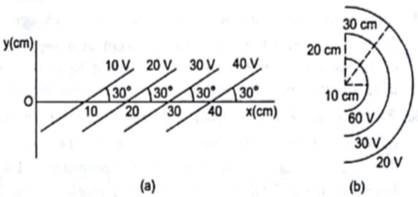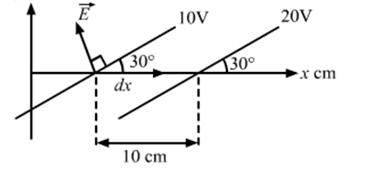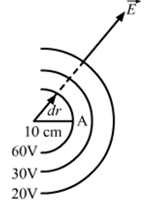Some equipotential surfaces are shown in figure. What can you say about the magnitude and the direction of the electric field?
Given:
From figure (a)
Angle between equipotential surfaces and the displacement x
:θ = 30°
Change in potential : dV = 10 V
Change in displacement between two consecutive equipotential surfaces: dx = 10 cm = 0.1 m
From figure (b)
Increase in radius from center: dr= 10cm=0.1m
Formula used:
(a)
As we know that the electric field ![]() is always perpendicular to the equipotential surface
is always perpendicular to the equipotential surface

From the above diagram, the angle between Electric field ![]() and dx ; θ’ = 90° +30° =120°
and dx ; θ’ = 90° +30° =120°
Change in electric potential is given as:![]()
![]()
![]()
![]()
![]() Hence the magnitude of electric field is 200 V/m making an angle of 120° with the x axis.
Hence the magnitude of electric field is 200 V/m making an angle of 120° with the x axis.
(b)
As we know that the electric field ![]() is always perpendicular to the equipotential surface
is always perpendicular to the equipotential surface
Radius increases by: dr= 10 cm = 0.1 m
As ![]() is perpendicular to the equipotential surface,
is perpendicular to the equipotential surface, ![]() and dr would be along same line as shown in the figure above.
and dr would be along same line as shown in the figure above.
Thus angle between ![]() and dr : θ = 0
and dr : θ = 0
We know that potential at a point due to a charge q is given as:![]() Where, k is a constant and k=
Where, k is a constant and k= ![]() =9× 109 Nm2C-2 . q is the point charge and r is radius of that surface.
=9× 109 Nm2C-2 . q is the point charge and r is radius of that surface.
Consider potential at point A where r=0.1 m![]()
![]()
![]() Electric field is given as:
Electric field is given as:![]() Substituting value of kq we get,
Substituting value of kq we get,![]() Hence, the magnitude of the electric field is
Hence, the magnitude of the electric field is ![]() and it’s direction is radially outward with decreasing with increasing radii.
and it’s direction is radially outward with decreasing with increasing radii.